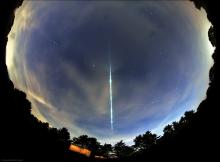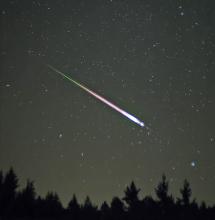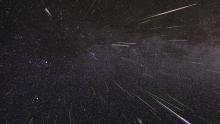Listen to today's episode of StarDate on the web the same day it airs in high-quality streaming audio without any extra ads or announcements. Choose a $8 one-month pass, or listen every day for a year for just $30.
You are here
Lyrid Meteors
The mild nights of spring are generally a good time for skywatching. Only one thing is missing: a great meteor shower. The really good showers are clustered in fall and winter, with the Perseids of August sometimes joining the list.
Although the season doesn’t offer a great shower, a pretty good one should reach its peak tomorrow night: the Lyrids. Under a dark sky, you might see a dozen or more meteors per hour between midnight and dawn. The number of meteors increases closer to dawn, as your part of Earth turns more directly into the meteor stream. And the Moon is new, so it’s not around to spoil the show.
One good thing about meteors, though, is that you don’t have to wait for a shower to see them.
A shower occurs when Earth passes through a stream of small bits of rock shed by a comet or asteroid, which happens a few times a year.
But other bits of rocky debris are scattered throughout the solar system. So on any dark night, you can see several meteors racing across the sky. And while the meteors in a shower all appear to “rain” into the sky from a common point in space, these “random” meteors can come from any direction.
So if you have a chance, look for the Lyrid meteor shower over the next few nights, and especially in the wee hours of Wednesday morning. If not, then take advantage of just about any clear, dark night to look for meteors flashing across the heavens.
We’ll talk about another meteor shower tomorrow.
Script by Damond Benningfield





